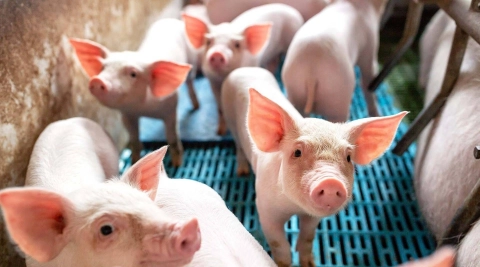Healthy living Food hygiene – don’t give germs a chance
Some microorganisms in food can make people sick. Most of these cause gastrointestinal illnesses, i.e. illnesses of the stomach and intestines. However, people can avoid infection by following a few basic hygiene rules when purchasing, storing and preparing food.
At a glance
- Food can contain both friendly and harmful microorganisms.
- Harmful microorganisms can cause infection and food poisoning, which usually trigger gastrointestinal symptoms in the stomach and gut, such as diarrhea with vomiting.
- Animal produce in particular, such as meat and eggs, may be contaminated with germs.
- However, microorganisms may also be present in plant-based foods, such as salads.
- If a small number of hygiene rules are observed when transporting, storing and preparing food and in controlling its temperature, this greatly reduces the risk of pathogens (disease-causing germs) being transmitted when the food is consumed.
Note: The information in this article cannot and should not replace a medical consultation and must not be used for self-diagnosis or treatment.

Why is hygiene important when handling food?
Microorganisms such as bacteria, viruses and fungi can be found on and in food. Not all of these are harmful – in fact, certain food products such as cheese and bread wouldn’t exist without microorganisms.
Bacteria even makes some foods healthier – for example, fermented food products such as yogurt and sauerkraut.
Sometimes, however, food contains microorganisms that can make people ill, especially if they are present in high concentrations. In most cases, pathogens that enter the body in food cause diarrhea with vomiting.
Video What is the microbiome?
Watch this video to find out more about the microbiome and its functions in the human body.
This and other videos can also be found on YouTube
Watch nowThe privacy policy indicated there applies.
Animal produce in particular, such as meat, fish, eggs and unpasteurized dairy products, may be contaminated with germs. If they are not transported, stored and prepared correctly, the germs may multiply and enter the body when the food is eaten. If food isn’t handled properly and kitchen hygiene standards are poor, microorganisms may also be transferred from animal produce to plant-based products.
What are infectious diseases?
The video below looks at when doctors talk about an infectious disease, which pathogens trigger infectious diseases, and how they are transmitted.
This and other videos can also be found on YouTube
Watch nowThe privacy policy indicated there applies.
How are microorganisms transmitted in food?
Many microorganisms that trigger gastrointestinal diseases in humans live unnoticed in the digestive tracts of various farm animals and wild animals. This is why animal produce in particular, such as meat, fish, eggs and unpasteurized dairy products, may be contaminated with germs. If animal produce is eaten raw or is undercooked, germs can enter the body when the food is eaten and then multiply in the human digestive tract.
Important: When animal produce is heated up sufficiently and properly cooked through, most of the pathogens it contains are killed and can no longer cause an infection.
Plant-based foods, for example field vegetables, can also be contaminated with disease-causing microorganisms. In rare cases, harmful microbes can also be found in preserved plant-based food, such as canned beans and peas or the toxins they produce.
Pathogens can also be passed from raw animal produce to plant-based foods if these are stored or processed together under unhygienic conditions. In addition, germs on the hands can make their way onto food if hands are not washed thoroughly before eating. Microorganisms can also be passed onto food from dirty worktops and kitchen utensils.
Important: Germs can be transmitted from contaminated food to contaminated food during storage, transport and preparation.
Which microorganisms cause foodborne illnesses?
If harmful microorganisms from food multiply in the body and cause an illness, this is referred to as a foodborne illness or infection. Bacteria are a common cause of foodborne illnesses – for example, Campylobacter, Salmonella and Yersinia. However, viruses (e.g. norovirus) or parasites (e.g. Toxoplasma gondii) can also cause foodborne infections.
Campylobacter
Infections with Campylobacter bacteria are common. A Campylobacter infection (campylobacteriosis) causes high temperature, headache and muscle cramps, vomiting, diarrhea and severe stomach aches. It can enter the body when people eat contaminated meat (especially poultry) and eggs. Campylobacter bacteria, unlike Salmonella, are unable to multiply on food. However, already a very small number of these bacteria can cause illness.
Salmonella
Salmonella bacteria are another frequent cause of foodborne infections. These bacteria can trigger an acute intestinal inflammation known as a Salmonella infection or salmonellosis. Salmonella bacteria are found in the gastrointestinal tract of many animals and can be passed on to humans via meat, sausages and eggs in particular.
Other diarrhea-causing pathogens
Yersinia bacteria are the third most common bacterial microbe (after Campylobacter and Salmonella) responsible for causing gastrointestinal illnesses in Germany. Yersiniosis, i.e. an infection with Yersinia, is transmitted via water, milk and meat (in most cases, from pigs). The symptoms of this illnesses differ from person to person, depending on their age and the condition of their immune system. Small children usually have gastrointestinal symptoms, while older children experience non-specific stomach ache and swelling of the lymph nodes. Adults experience flu-like symptoms with neck pain.
Other major causes of diarrhea transmitted via food are noroviruses and enterohemorrhagic Escherichia coli (EHEC or E. coli for short).
Listeria and toxoplasmosis
An infection with Listeria (listeriosis) is relatively rare and, in healthy people, normally occurs with mild symptoms or none at all. Despite this, Listeria is a significant foodborne microbe because it can cause severe illness, such as blood poisoning (sepsis) in at-risk groups. It can also cause serious damage to unborn babies and can lead to a miscarriage. Listeria bacteria are common in the environment and in the intestinal tract of farm animals and, as a result, can be transmitted to humans via various foods, such as unpasteurized milk or the rinds of soft cheeses.
For people with a suppressed immune system and for pregnant women and their unborn babies, both Listeria and toxoplasmosis present a serious health risk. Toxoplasmosis can occur as a result of eating raw or undercooked meat, for example.
For more information about the various pathogens – for example, about transmission and symptoms – visit infektionsschutz.de.
Which microorganisms cause food poisoning?
Food poisoning is also largely caused by bacteria, such as various types of Clostridia and Staphylococci bacteria. For food poisoning to occur, the pathogenic microbes themselves don’t necessarily need to establish themselves in the body. People can become ill simply by eating food that contains toxins produced by the microorganisms.
Toxin-producing, spore-forming bacteria
Some types of bacteria that produce toxins can also form spores. Unlike active bacteria, these inactive spores can survive hostile conditions, such as very high temperatures when heating food up. Once the spores find themselves in a favorable environment – for example, in food that is being kept warm – they can once again develop into active bacteria, multiply in number and produce toxins. Clostridium perfringens and Bacillus cereus are two important examples of spore-forming, toxin-producing bacteria. C. perfringens multiplies particularly effectively in food containing protein (such as meat or peas) that has not been stored at a sufficiently hot or cold temperature. B. cereus largely multiplies in starchy foods (such as pasta and rice) that are kept warm for long periods or are not refrigerated.
Another significant toxin-producing, spore-forming type of bacteria is Clostridium botulinum. The botulinum toxin produced by these bacteria is very toxic and can cause respiratory paralysis. The Botulinum bacteria can be found in foods that were not properly preserved – for example, in canned food that was not sufficiently heated during canning or in sausage products that were not manufactured correctly.
Staphylococci
Staphylococci bacteria live on the skin and in the mucous membranes of the nose and throat in humans and animals. As a result of poor food hygiene – for example, during the processing of food – the bacteria can contaminate food and produce various toxins in food that are poisonous to humans. If a large volume of toxin is consumed, this usually causes nausea and diarrhea. However, the symptoms generally only last for a day.
What hygiene rules need to be observed when handling food?
In many cases, consumers are unable to tell whether food is contaminated with microorganisms. Therefore, it’s important to transport, store and prepare food correctly – even if it appears to be very fresh – and to maintain good hygiene standards in the kitchen. Thorough handwashing before, during and after food preparation is also recommended.
Video How can foodborne infections be prevented?
The following video explains what can be done to prevent foodborne infections.
This and other videos can also be found on YouTube
Watch nowThe privacy policy indicated there applies.
Purchase and transport
Perishable foods, such as meat, fish and dairy products – should always be refrigerated because lower temperatures prevent microorganisms from multiplying. For refrigerated and frozen foods, interruptions of the cold chain should be kept as short as possible. These foods are best transported home in a cooler bag, especially during the summer months. At home, these foods should be placed in the refrigerator or freezer without delay.
Storage
Contamination can be prevented by covering food entirely or storing it in sealed containers.
Food that perishes easily, such as meat, fish and dairy products, belong in the refrigerator until they are going to be eaten. These foods should ideally be stored on the glass shelf at the bottom of the refrigerator, as this is the coldest spot.
Pre-prepared salads and fruit are also best kept refrigerated. This prevents bacteria from multiplying, as many types of bacteria cannot multiply or only do so to a very limited extent at low temperatures. It’s important to ensure that the temperature in the refrigerator doesn’t exceed 7 degrees Celsius. Temperatures below 5 degrees Celsius are best. Avoid overloading the refrigerator so that the cooled air has enough room to circulate and can be distributed evenly. It’s also important to clean refrigerators several times a year.
Any meal leftovers should be cooled quickly, stored in the refrigerator and used within 2 or 3 days at most.
For more information about storing and preserving food, visit the website of the Federal Office of Consumer Protection and Food Safety (BVL).
Preparation
When preparing food, it’s important to pay attention to personal hygiene and to ensure that all surfaces and kitchen utensils are clean.
Regular handwashing, both before preparing food and between individual steps, reduces the risk of germs being passed from contaminated foods to other foods. This is particularly important when handling raw animal produce. It’s also important to avoid touching the mouth, nose or hair during food preparation so that no microorganisms are transferred to the food.
Important: Anyone who is ill with a gastrointestinal illness should avoid preparing food for other people due to the risk of infection.
Raw plant-based foods, such as fruit, vegetables, herbs, sprouts and green salad, must also be washed carefully before consumption – ideally under running water. If vegetables that are grown in soil are eaten raw, peeling can further reduce the risk of infection. Sprouts and frozen berries can also be heated up before being eaten to kill microorganisms.
When preparing food, different food types should be stored and processed separately. It is particularly important to use separate kitchen utensils for raw fish and raw meat. Alternatively, chopping boards and knives can be washed thoroughly with warm water and dishwashing liquid between each step in the process of preparing the food. Chopping boards made of plastic rather than wood are better for preparing raw animal produce as they are easier to clean.
As many germs can be found in packaging and in condensation water of meat and poultry, both should be disposed of immediately and anything that has come into contact with these should be cleaned without delay.
Animal produce and meal leftovers should always be properly cooked through or heated up in order to kill disease-carrying microbes. This means that the internal temperature of the food should reach at least 70 degrees Celsius for a minimum of 2 minutes. A meat thermometer can be used to test the temperature of meat. It is advisable to boil unpasteurized milk before consuming it.
When it comes to eating eggs, the Federal Institute for Risk Assessment (BfR) recommends a number of hygiene measures for avoiding infections with Campylobacter bacteria in particular.
Keeping food warm
When meals have to be kept warm for extended periods, the Federal Institute for Risk Assessment (BfR) recommends that the temperature be constantly maintained at 60 degrees Celsius on all sides. At temperatures below 60 degrees Celsius, many bacteria (such as Bacillus cereus) can multiply effectively and produce toxins.
When is particular caution required?
Healthy people who follow a few basic hygiene rules don’t generally need to worry about contracting a foodborne illness or food poisoning. However, certain groups of people are at an increased risk of becoming ill in this way. These include:
- people with a weakened immune system as a result of an illness or of taking certain medication
- those of older age
- infants and small children
- pregnant women and unborn babies
When preparing food for people in these groups, it is particularly important to ensure good food hygiene. There are also some additional things to consider for those at increased risk. For example, they should not eat any food past its best-before date. There are also some foods they should avoid, such as:
- unpasteurized milk and unpasteurized dairy products
- soft cheeses made from pasteurized milk if they have been ripened using yellow or red smear bacterial strains
- raw eggs or dishes made with raw eggs (e.g. tiramisu)
- raw meat and mince
- raw sausage, e.g. “Mettwurst” – an uncooked sausage made from ground pork
- smoked or raw fish, e.g. smoked salmon or sushi
The article “Nutrition during pregnancy” provides detailed information about other important aspects of nutrition during this important stage of life.
What to do if poisoning is suspected
If you are concerned that you or someone you are with has ingested a poisonous substance, you should contact your local poison control center immediately. Poison control centers are contactable 24 hours a day.
For a complete overview of emergency phone numbers for poison control centers, see the website of the Federal Institute for Risk Assessment (BfR).
Where to go for more information about food hygiene
For more information and useful tips on preventing foodborne infections, see the consumer tips provided by the Federal Institute for Risk Assessment (BfR).
- Bundesamt für Verbraucherschutz und Lebensmittelsicherheit (BVL). Infektionen mit Campylobacter. Aufgerufen am 26.10.2021.
- Bundesamt für Verbraucherschutz und Lebensmittelsicherheit (BVL). Infektion mit EHEC. Aufgerufen am 26.10.2021.
- Bundesamt für Verbraucherschutz und Lebensmittelsicherheit (BVL). Infektion mit Listerien. Aufgerufen am 26.10.2021.
- Bundesamt für Verbraucherschutz und Lebensmittelsicherheit (BVL). Infektion mit Salmonellen. Aufgerufen am 26.10.2021.
- Bundesamt für Verbraucherschutz und Lebensmittelsicherheit (BVL). Intoxikation mit Clostridium botulinum. Aufgerufen am 26.10.2021.
- Bundesamt für Verbraucherschutz und Lebensmittelsicherheit (BVL). Intoxikation durch Staphylokokkus aureus. Aufgerufen am 26.10.2021.
- Bundesinstitut für Risikobewertung (BfR). Hygiene fürs Hühnerei – Schutz vor Campylobacter. Stellungnahme vom 11. Mai 2018.
- Bundesinstitut für Risikobewertung (BfR). Schutz vor lebensmittelbedingten Erkrankungen beim Heißhalten von Speisen. Stellungnahme vom 27. August 2020.
- Bundesinstitut für Risikobewertung (BfR). Schutz vor Lebensmittelinfektionen im Privathaushalt. Verbrauchertipps. 2020.
- Bundesinstitut für Risikobewertung (BfR). Yersinien. Aufgerufen am 26.10.2021.
- Bundesamt für Verbraucherschutz und Lebensmittelsicherheit (BVL). Überblick über lebensmittelbedingte Infektionen und Intoxikationen. Aufgerufen am 26.10.2021.
- Bundeszentrale für gesundheitliche Aufklärung (BZgA), infektionsschutz.de. Küchen- und Lebensmittelhygiene. Aufgerufen am 28.10.2021.
- Bundeszentrale für gesundheitliche Aufklärung (BZgA), infektionsschutz.de. Lebensmittelinfektion. Aufgerufen am 26.10.2021.
- Niedersächsisches Landesamt für Verbraucherschutz und Lebensmittelsicherheit (Laves). Clostridium perfringens. Aufgerufen am 27.10.2021.
- Niedersächsisches Landesamt für Verbraucherschutz und Lebensmittelsicherheit (Laves). Hygieneregeln im Haushalt. Aufgerufen am 28.10.2021.
- Robert Koch-Institut (RKI). Staphylokokken-Erkrankungen, insbesondere Infektionen durch MRSA. Aufgerufen am 28.10.2021.
- Robert Koch-Institut (RKI). Toxoplasmose. Aufgerufen am 26.10.2021.
In cooperation with the Federal Center for Health Education (Bundeszentrale für gesundheitliche Aufklärung – BZgA).
As at:





